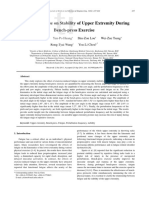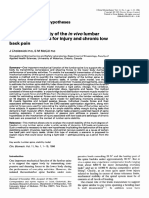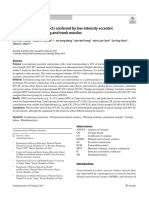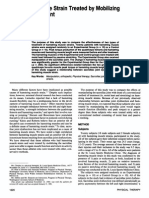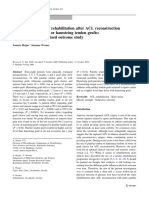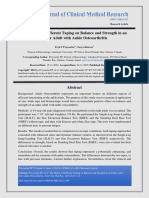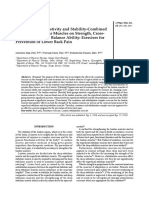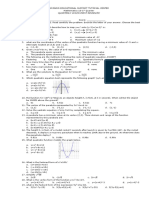Effect of Kinesio Taping On Muscle Strength in Athletes - A Pilot Study
Effect of Kinesio Taping On Muscle Strength in Athletes - A Pilot Study
Uploaded by
Ernesto LlorcaCopyright:
Available Formats
Effect of Kinesio Taping On Muscle Strength in Athletes - A Pilot Study
Effect of Kinesio Taping On Muscle Strength in Athletes - A Pilot Study
Uploaded by
Ernesto LlorcaOriginal Title
Copyright
Available Formats
Share this document
Did you find this document useful?
Is this content inappropriate?
Copyright:
Available Formats
Effect of Kinesio Taping On Muscle Strength in Athletes - A Pilot Study
Effect of Kinesio Taping On Muscle Strength in Athletes - A Pilot Study
Uploaded by
Ernesto LlorcaCopyright:
Available Formats
Journal of Science and Medicine in Sport (2008) 11, 198201
SHORT REPORT
Effect of Kinesio taping on muscle strength in
athletesA pilot study
Tieh-Cheng Fu, Alice M.K. Wong, Yu-Cheng Pei , Katie P. Wu,
Shih-Wei Chou, Yin-Chou Lin
Department of Physical Medicine and Rehabilitation, Chang Gung University, Taiwan
Received 6 July 2006 ; received in revised form 31 January 2007; accepted 18 February 2007
KEYWORDS
Isokinetic;
Muscle strength;
Taping;
Kinesio taping;
Athlete
Summary Muscle strength is a key component of an athletes performance and may
be influenced by taping. This study examined the possible immediate and delayed
effects of Kinesio taping on muscle strength in quadriceps and hamstring when taping
is applied to the anterior thigh of healthy young athletes. Fourteen healthy young
athletes (seven males and seven females) free of knee problems were enrolled in
this study. Muscle strength of the subject was assessed by the isokinetic dynamometer under three conditions: (1) without taping; (2) immediately after taping; (3) 12 h
after taping with the tape remaining in situ. The result revealed no significant difference in muscle power among the three conditions. Kinesio taping on the anterior
thigh neither decreased nor increased muscle strength in healthy non-injured young
athletes.
2007 Sports Medicine Australia. Published by Elsevier Ltd. All rights reserved.
Introduction
Kinesio tape, invented by Kenzo Kase in 1996, is
a new application of adhesive taping. It is a thin
and elastic tape which can be stretched up to
120140% of its original length, making it quite
elastic and resulting in less mechanism constraints,
compared with conventional tape. Kinesio taping,
an organised wrapping technique using Kinesio tape
proposed by Kase, is claimed to be able to reduce
pain, swelling and muscle spasms, as well as to prevent sport injury.1
Corresponding author.
E-mail addresses: mr5598@adm.cgmh.org.tw,
fic6481@tcts1.seed.net.tw (Y.-C. Pei).
Taping is widely used to prevent injury to
athletes.2 The therapeutic effects of knee taping include minimising pain, increasing muscle
strength, improving gait pattern and enhancing functional outcome of patients with sports
injury, osteoarthritis (OA) and patellofemoral pain
(PFP).3,4
Taping may increase or reduce muscle strength,
and many investigators hypotheses to explain the
possible underlying mechanism, including neurofacilitation and mechanical restraint (e.g., Macgregor
et al.) have identified the relationship between
cutaneous afferent stimulation and motor unit
firing.5 Conversely, Cools et al. observed no significant influence of tape on electromyography activity
in the scapular muscles of healthy subjects.2 How-
1440-2440/$ see front matter 2007 Sports Medicine Australia. Published by Elsevier Ltd. All rights reserved.
doi:10.1016/j.jsams.2007.02.011
Kinesio taping and muscle strength
199
ever, few studies have measured the effectiveness
of Kinesio taping and these studies have obtained
inconsistent results.1,6 The main goal in this study is
to answer the question whether muscle power could
be changed by Kinesio taping. Hence, this study
investigates the effects of Kinesio taping on muscle
strength after application of taping on the anterior knee and thigh, and the immediate and delayed
effects of Kinesio taping that may be relevant for
clinical application.
Materials and methods
Subjects
The subjects were the college athletes of the
Nation College of Physical Education and Sports
majoring in kickboxing. Fourteen healthy athletes, seven males and seven females (mean age,
19.7 1.0 years, mean body height 168.9 6.1 cm,
mean body weight 60.3 8.2 kg), were enrolled in
this study. Informed consent in accordance with
institutional ethical standards of the ethics committee on human experimentation was obtained from
each subject. Those who reported active knee pain,
trauma in the lower limbs within the previous 3
months or any surgery history for the lower limbs
were excluded.
Instrumentation
The Cybex NORM isokinetic dynamometer (Lumex
Corporation, Ronkonloma, NY, USA) was adopted
to assess concentric and eccentric muscle
strength in the quadriceps and hamstring muscles while contracting at a speed of 60 /s and
180 /s.
Subjects were taped with a Y-shaped Kinesio tape
at the quadriceps according to the Kenzo Kases
Kinesio taping manual (Kase et al., 1996)7 by the
same physician. The dominant side of the subjects
knees were taped. Fig. 1 illustrates the subjects
posture when Kinesio taping is being applied. The
subjects lay in the supine position with the hip
flexed at 30 and the knee flexed at 60 . The
tape was applied from a point 10 cm inferior to
the anterior superior iliac spine, bisected at the
junction between quadriceps femoris tendon and
the patella, and circled around the patella, ending at its inferior side. The first 5 cm of tape were
not stretched and acted as the anchor. The portion between the anchor and superior patella was
stretched to 120%. The remaining tape around the
patella remained un-stretched.
Figure 1 The taping method and the subjects posture
when applying Kinesio taping.
Test protocol
Taping conditions
Three taping conditions were applied to each subject: (1) without taping (WT); (2) immediately
under taping (IT); (3) 12 h after taping and with
the tape still in situ (AT). Subjects were assessed
in each condition by three daily activities and
muscle strength was measured by the isokinetic
dynamometer.
The order of the three conditions was randomised using a random number allocation table.
To avoid any bias resulting from muscle fatigue
induced by the previous isokinetic assessments,
the inter-assessment intervals were at least
7 days.
Isokinetic muscle strength
Muscle strength was evaluated using a Cybex
NORM. Each subject was given verbal instructions
to maximise effort and was allowed to see the
monitor. The sequence of evaluation was as follows: concentric quadriceps contractions at 60 /s;
eccentric quadriceps contractions at 60 /s; concentric quadriceps contractions at 180 /s and
eccentric quadriceps contraction at 180 /s. The
same testing protocol was repeated to test hamstring muscle strength.
Data analysis
Analysis by ANOVA for repeated measures (three
conditions) was used to assess the effect of Kinesio taping on muscle strength. Main effect analysis
was applied in cases of significant difference among
the three assessments. Estimates of effect size
were analysed using the partial eta-squared method
to describe the proportion of total variability
200
T.-C. Fu et al.
Table 1 Comparison of peak torque, and total work of quadriceps and hamstring muscles, and functional activity
among the three taping conditions
Concentric/eccentric
Velocity
( /s)
Contractor
Condition
WT
IT
p-Value
Effect
size
AT
Peak torque (kg m)
Concentric
Eccentric
Concentric
Eccentric
Concentric
Eccentric
Concentric
Eccentric
60
60
180
180
60
60
180
180
Quadriceps
Quadriceps
Quadriceps
Quadriceps
Hamstring
Hamstring
Hamstring
Hamstring
43.8
45.4
33.2
39.4
26.2
25.3
23.7
21.1
13.4
16.1
10.6
13.6
10.3
7.5
8.1
6.8
40.9
43.4
32.4
37.9
25.3
23.7
22.9
19.5
12.2
14.1
12.0
13.5
9.3
7.1
7.5
6.0
43.0
44.7
36.4
41.4
25.6
24.0
22.2
19.5
12.3
14.6
12.3
13.8
8.2
7.0
7.2
6.1
0.323
0.597
0.027a
0.194
0.568
0.108
0.496
0.194
0.083
0.039
0.242
0.119
0.043
0.157
0.052
0.119
Total work (kg m)
Concentric
Eccentric
Concentric
Eccentric
Concentric
Eccentric
Concentric
Eccentric
60
60
180
180
60
60
180
180
Quadriceps
Quadriceps
Quadriceps
Quadriceps
Hamstring
Hamstring
Hamstring
Hamstring
27.4
28.0
22.5
26.7
22.2
18.9
21.2
16.0
8.1
10.8
6.2
8.9
9.5
4.5
7.4
4.0
25.7
29.1
21.2
28.2
21.7
18.4
19.9
15.6
6.9
12.3
6.4
10.9
8.9
4.8
6.6
4.4
26.1
29.3
22.9
28.2
22.7
19.1
20.6
16.4
6.6
10.2
6.1
8.4
8.4
5.1
7.4
4.0
0.466
0.708
0.330
0.571
0.474
0.582
0.486
0.382
0.050
0.026
0.082
0.033
0.056
0.041
0.054
0.071
WT: without taping; IT: immediately after taping; AT: 12 h after taping; ab: comparing WT and IT, bc: comparing IT and AT; ac:
comparing AT and WT.
a Difference: AB, AC.
attributable to each factor. Statistical significance
was set at p < 0.05.
Results
Two data were excluded from data analysis due
to the subjects factor; final data for analysis
consisted of seven males and seven females. All
subjects were healthy athletes, and none complained of pain or discomfort during examination.
Evaluation of comparison of peak torque and
total work of quadriceps and hamstring muscle by
isokinetic assessments was shown in Table 1. The
ANOVA for repeated measures for the three conditions indicated that WT had the lowest peak
torque among the three conditions in concentric
contraction of the quadriceps at 180 /s (p < 0.05).
No significant differences existed among subjects
in other assessments. Additionally, no significant
interaction effect existed between conditions and
assessments (p > 0.05).
Discussion
The results suggest that Kinesio taping does not
enhance nor inhibit muscle strength when applied
to the thighs and knees of healthy athletes. This
finding is contrary to the claim that tape applied
under tension in the direction of muscle fibres
facilitates the strength of the underlying muscle.8
However, this study obtained a result similar to that
obtained by Janwantanakul,9 who indicated that
taping does not affect the muscle activities measured by electromyography. In this study, Kinesio
taping applied to skin apparently provided tactile
input. However, tactile input has been reported
to interact with motor control by altering the
excitability of the central neuron system.10,11 The
negative results observed in this study can be
explained by the fact that tactile input generated
by Kinesio taping may not be strong enough to modulate muscle power of healthy athletes.
This study does not support the existence of
probable effects on muscle power induced by Kinesio taping. Both the target muscles for taping,
the quadriceps, and the antagonist muscle, the
hamstrings, were assessed. Kinesio taping did not
generate any inhibition or facilitation in all tested
muscles. The only significant difference observed
for peak torque during concentric contraction of
quadriceps at 180 /s can be explained as a type
II error resulting from multiple comparisons.
To minimise the possible selection bias, we
recruited the subjects with the same background,
Kinesio taping and muscle strength
the college athletes of the Nation College of Physical Education and Sports majoring in kickboxing.
We supposed that a relatively homogeneous group
would yield less variance in their performance,
because they were majoring in the same subject
and under the same training course.
In conclusion, Kinesio taping on the knee does
not affect muscle performance of healthy young
athletes. The effectiveness of Kinesio taping for
pain relief, promotion of circulation and relief of
muscle spasm need further investigation in acute
injured athletes in the future.
Practical implications
Kinesio taping neither decreases nor increases
muscle power in uninjured athletes.
The ineffectiveness of changing muscle power
by Kinesio taping is observed immediately and
12 h after the application.
The effect of Kinesio taping on muscle power
of injured athletes has not been confirmed yet.
References
1. Halseth T, McChesney JW, DeBeliso M, et al. The effects of
Kinesio taping on proprioception at the ankle. J Sports Sci
Med 2004;3:17.
201
2. Cools AM, Witvrouw EE, Danneels LA, et al. Does taping
influence electromyographic muscle activity in the scapular rotators in healthy shoulders? Manual Ther 2002;7:
15462.
3. Hinman RS, Bennell KL, Crossley KM, et al. Immediate
effects of adhesive tape on pain and disability in individuals with knee osteoarthritis. Rheumatology 2003;42:
8659.
4. Ernst GP, Kawaguchi J, Saliba E. Effect of patellar taping on knee kinetics of patients with patellofemoral
pain syndrome. J Orthop Sports Phys Ther 1999;29:
6617.
5. Macgregor K, Gerlach S, Mellor R, et al. Cutaneous stimulation from patella tape causes a differential increase in
vasti muscle activity in people with patellofemoral pain. J
Orthop Res 2005;23:3518.
6. Murray H, Husk L. Effects of Kinesio taping on proprioception in the ankle. J Orthop Sports Phys Ther 2001;31:
A-37.
7. Kase K, Tatsuyuki H, Tomoko O. Development of Kinesio
tape. Kinesio Taping Perfect Manual. Kinesio Taping Association 1996;610:1178.
8. Morrissey D. Proprioceptive shoulder taping. J Bodywork
Movement Ther 2000;4:18994.
9. Janwantanakul P, Gaogasigam C. Vastus lateralis and vastus
medialis obliquus muscle activity during the application of
inhibition and facilitation taping techniques. Clin Rehabil
2005;19:129.
10. Ridding MC, Brouwer B, Miles TS, et al. Changes in muscle
responses to stimulation of the motor cortex induced by
peripheral nerve stimulation in human subjects. Exp Brain
Res 2000;131:13543.
11. Simoneau GG, Degner RM, Kramper C, et al. Changes in
ankle joint proprioception resulting from strips of athletic
tape applied over the skin. J Athl Train 1997.
Available online at www.sciencedirect.com
You might also like
- Kiara Jamison Insurance CardDocument1 pageKiara Jamison Insurance CardLillian AwtNo ratings yet
- Effects of Fatigue On Stability of Upper Extremity During Bench-Press ExerciseDocument5 pagesEffects of Fatigue On Stability of Upper Extremity During Bench-Press Exerciseyp huangNo ratings yet
- Kinesio PDFDocument4 pagesKinesio PDFmohamedwhateverNo ratings yet
- Manual Therapy: Original ArticleDocument5 pagesManual Therapy: Original ArticleCleber PimentaNo ratings yet
- Obesity CuadricepsDocument5 pagesObesity CuadricepsGonzalo Aguayo AlcayagaNo ratings yet
- Absctrac Congreso NSCADocument144 pagesAbsctrac Congreso NSCAMelina LabroneNo ratings yet
- The Effects of Kinesio Taping On Quadriceps Strenth During Isokinetic Exercise in Healthy Non-Athlete WomenDocument6 pagesThe Effects of Kinesio Taping On Quadriceps Strenth During Isokinetic Exercise in Healthy Non-Athlete WomenionNo ratings yet
- Articulo #30Document8 pagesArticulo #30LAURA CAMILA CUBILLOS VILLAMILNo ratings yet
- E F T S E - M D: AP S: Ffect of Lexibility Raining On Ymptoms OF Xercise Induced Uscle Amage Reliminary TudyDocument7 pagesE F T S E - M D: AP S: Ffect of Lexibility Raining On Ymptoms OF Xercise Induced Uscle Amage Reliminary TudySudhakar SubramanianNo ratings yet
- How Long Does The Protective Effect On Eccentric Exercise-Induced Muscle Damage Last?Document6 pagesHow Long Does The Protective Effect On Eccentric Exercise-Induced Muscle Damage Last?Ricardo Pereira NevesNo ratings yet
- Effects of Stretching On Passive Muscle Tension and Response To Eccentric ExerciseDocument8 pagesEffects of Stretching On Passive Muscle Tension and Response To Eccentric ExerciseRuben CapelaNo ratings yet
- Ações ExcentricasDocument5 pagesAções ExcentricasJonatas GomesNo ratings yet
- ijes-12-1-950 singlelegsquatvariationDocument10 pagesijes-12-1-950 singlelegsquatvariationAndrea MaccaroniNo ratings yet
- The Effects of Proprioceptive or Strength Training On The Neuromuscular Function of The ACL Reconstructed Knee - A Randomized Clinical TrialDocument9 pagesThe Effects of Proprioceptive or Strength Training On The Neuromuscular Function of The ACL Reconstructed Knee - A Randomized Clinical Trialsabilillah putri63No ratings yet
- Forward LungeDocument7 pagesForward LungeJune Nicca MedinaNo ratings yet
- A Comparison Between Two Active Stretching Techniques On Hamstrings Flexibility in Asymptomatic IndividualsDocument5 pagesA Comparison Between Two Active Stretching Techniques On Hamstrings Flexibility in Asymptomatic IndividualsIOSRjournalNo ratings yet
- Aductor TestDocument8 pagesAductor TestCarles PeiroNo ratings yet
- Effects of Horizontal and Incline Bench Press On Neuromuscular Adaptations in Untrained Young MenDocument14 pagesEffects of Horizontal and Incline Bench Press On Neuromuscular Adaptations in Untrained Young MenAndré Evandro MartinsNo ratings yet
- (534816417) DownloadDocument7 pages(534816417) Downloadpito12No ratings yet
- 1 s2.0 S1440244012001211 MainDocument5 pages1 s2.0 S1440244012001211 MainIsaac ZoudNo ratings yet
- Physiotherapy: P. Ratan Khuman Lourembam Surbala Priyanka Patel Dhara ChavdaDocument4 pagesPhysiotherapy: P. Ratan Khuman Lourembam Surbala Priyanka Patel Dhara ChavdaSahithya MNo ratings yet
- Biomechanics of The Knee During Closed Kinetic Chain and Open KineticDocument17 pagesBiomechanics of The Knee During Closed Kinetic Chain and Open KineticArmando NetoNo ratings yet
- Análise EMG de Músculos Das Extremidades Inferiores em Três Diferentes Exercícios de AgachamentoDocument6 pagesAnálise EMG de Músculos Das Extremidades Inferiores em Três Diferentes Exercícios de AgachamentoSheilani MartinsNo ratings yet
- Activation and Torque Deficits in ACL-Reconstructed Patients 4 Months Post-OperativeDocument15 pagesActivation and Torque Deficits in ACL-Reconstructed Patients 4 Months Post-OperativeEurovision RSNo ratings yet
- Cho LewickiDocument15 pagesCho Lewickii_anitaNo ratings yet
- 2004 Mcgill Ab Bracing ArtcileDocument12 pages2004 Mcgill Ab Bracing ArtcileDemetriusNo ratings yet
- Effects of Kinesiology Taping On Repositioning Error of The Knee Joint After Quadriceps Muscle FatigueDocument3 pagesEffects of Kinesiology Taping On Repositioning Error of The Knee Joint After Quadriceps Muscle FatigueYoga MatiinuNo ratings yet
- Damage Protective Effects Conferred by Low Intensity Eccentric ContractionsDocument10 pagesDamage Protective Effects Conferred by Low Intensity Eccentric Contractionsvmontezano2024No ratings yet
- European J App Phys - Effectiveness of Using Wearable Vibration Therapy T PDFDocument9 pagesEuropean J App Phys - Effectiveness of Using Wearable Vibration Therapy T PDFFrancisco Javier Medina CaballeroNo ratings yet
- Andersen Et Al., 2005 (JAP) Changes in The Human Muscle Force-Velocity Relationship in ResponseDocument9 pagesAndersen Et Al., 2005 (JAP) Changes in The Human Muscle Force-Velocity Relationship in Responsedianamarcela1200No ratings yet
- Muscular Pain & Kinesio® Taping: The Effect of Kinesio Taping® On Muscular Micro-Damage Following Eccentric ExercisesDocument7 pagesMuscular Pain & Kinesio® Taping: The Effect of Kinesio Taping® On Muscular Micro-Damage Following Eccentric ExercisesAna Lu LoboNo ratings yet
- Hamstring Muscle Strain Treated by Mobilizing The Sacroiliac JointDocument4 pagesHamstring Muscle Strain Treated by Mobilizing The Sacroiliac JointKarthik BhashyamNo ratings yet
- 2008-Croisier-Strength Imbalances and Prevention of Hamstring Injury in Professional Soccer Players - Isokinetic HQ RatioDocument7 pages2008-Croisier-Strength Imbalances and Prevention of Hamstring Injury in Professional Soccer Players - Isokinetic HQ RatioFederico BristotNo ratings yet
- Eight Weeks of Proprioceptive Neuromuscular FaciliDocument9 pagesEight Weeks of Proprioceptive Neuromuscular FaciliMauricio MoncadaNo ratings yet
- Effects of Electrical Muscle Stimulation On Body Composition, Muscle StrengthDocument8 pagesEffects of Electrical Muscle Stimulation On Body Composition, Muscle StrengthphuawlNo ratings yet
- Full TextDocument9 pagesFull TextdespNo ratings yet
- Effect of Isometric Quadriceps Exercise On Muscle Strength, Pain, and Function in Patients With Knee Osteoarthritis: A Randomized Controlled StudyDocument4 pagesEffect of Isometric Quadriceps Exercise On Muscle Strength, Pain, and Function in Patients With Knee Osteoarthritis: A Randomized Controlled StudyHusnannisa ArifNo ratings yet
- The Effect of Different Taping On Balance and Strength in An Older Adult With Ankle OsteoarthritisDocument14 pagesThe Effect of Different Taping On Balance and Strength in An Older Adult With Ankle OsteoarthritisAthenaeum Scientific PublishersNo ratings yet
- Ankle SprainDocument7 pagesAnkle SprainZawirNo ratings yet
- 23 247Document4 pages23 247Ita MagdalenaNo ratings yet
- Accepted ManuscriptDocument18 pagesAccepted ManuscriptDyah SafitriNo ratings yet
- 1.research PaperDocument18 pages1.research PaperbinNo ratings yet
- 26 - Jpts 2014 106Document2 pages26 - Jpts 2014 106Fashionnift NiftNo ratings yet
- Comparação Isot IsomeDocument7 pagesComparação Isot IsomecarlosNo ratings yet
- The Effect of Trunk Strengthening Exercise Using Oscillation On Trunk Muscle Thickness and BalanceDocument11 pagesThe Effect of Trunk Strengthening Exercise Using Oscillation On Trunk Muscle Thickness and Balancekang soon cheolNo ratings yet
- Determining The Stabilizing Role of Individual Torso Muscles During Rehabilitation ExercisesDocument13 pagesDetermining The Stabilizing Role of Individual Torso Muscles During Rehabilitation Exercisesx-ray7No ratings yet
- Effects of Antagonist Stretching On Agonist PerformanceDocument10 pagesEffects of Antagonist Stretching On Agonist PerformancechrisNo ratings yet
- Acute StretchDocument11 pagesAcute StretchGeorge M. PamborisNo ratings yet
- Calatayud Et Al.,2014 (Bench Press and Push-Ups at Comparable EMG Levels Strength Gains)Document8 pagesCalatayud Et Al.,2014 (Bench Press and Push-Ups at Comparable EMG Levels Strength Gains)AnaNo ratings yet
- Kim Et Al - Emg, Core - 2016Document27 pagesKim Et Al - Emg, Core - 2016Lina M GarciaNo ratings yet
- Sex comparisons of strength and coactivation followingDocument11 pagesSex comparisons of strength and coactivation followingvmontezano2024No ratings yet
- JKPT 35 5 125Document7 pagesJKPT 35 5 125tayfunertebelNo ratings yet
- Beda Pir Dan Met Pada FleksibilitasDocument5 pagesBeda Pir Dan Met Pada FleksibilitasPradipta EstuNo ratings yet
- Eccentric Exercise Reduces Upper Trapezius MuscleDocument9 pagesEccentric Exercise Reduces Upper Trapezius MuscleSarah TawfekNo ratings yet
- Sorichteretal MSSE1997Document15 pagesSorichteretal MSSE1997leal thiagoNo ratings yet
- Effects of Contract-Relax Vs Static Stretching On Stretch-Induced Strength Loss and Length-Tension RelationshipDocument6 pagesEffects of Contract-Relax Vs Static Stretching On Stretch-Induced Strength Loss and Length-Tension Relationshipjul yanNo ratings yet
- Effects_of_Static_and_Dynamic_StretchingDocument8 pagesEffects_of_Static_and_Dynamic_Stretchingmohammad2004arNo ratings yet
- Zaccas, 2005Document7 pagesZaccas, 2005Pablo fernandezNo ratings yet
- Cartilage Injury of the Knee: State-of-the-Art Treatment and ControversiesFrom EverandCartilage Injury of the Knee: State-of-the-Art Treatment and ControversiesAaron J. KrychNo ratings yet
- Krosales@cosanber - CL: Colegio Santa Bernardita Asignatura: Inglés Cursos: NM1A/NM1 B Mrs Karen Rosales AravenaDocument2 pagesKrosales@cosanber - CL: Colegio Santa Bernardita Asignatura: Inglés Cursos: NM1A/NM1 B Mrs Karen Rosales AravenaErnesto LlorcaNo ratings yet
- Evidence Summary - Cancer PainDocument12 pagesEvidence Summary - Cancer PainErnesto LlorcaNo ratings yet
- Journal of Herbal Medicine: Jan M.A. Van Der Valk, Christine J. Leon, Mark NesbittDocument12 pagesJournal of Herbal Medicine: Jan M.A. Van Der Valk, Christine J. Leon, Mark NesbittErnesto LlorcaNo ratings yet
- 10 1016@j Eujim 2017 03 005Document8 pages10 1016@j Eujim 2017 03 005Ernesto LlorcaNo ratings yet
- Blue Print For Question Paper PatternDocument4 pagesBlue Print For Question Paper PatternBasava VillanNo ratings yet
- Mineral Insulating OilDocument96 pagesMineral Insulating OilnbhawyaNo ratings yet
- Diploma Operating System Chapter 1Document68 pagesDiploma Operating System Chapter 1Alvin ChinNo ratings yet
- Nga Compliant 2021Document7 pagesNga Compliant 2021Belle ObradorNo ratings yet
- Instruction Manual: Esteemed ClientsDocument13 pagesInstruction Manual: Esteemed ClientsgiusssyNo ratings yet
- CONTRASTIVE ANALYSIS of Relative ClausesDocument42 pagesCONTRASTIVE ANALYSIS of Relative Clausessparkling9No ratings yet
- Engineering Thermodynamics Introduction and Basic ConceptsDocument16 pagesEngineering Thermodynamics Introduction and Basic ConceptsHassanKMNo ratings yet
- Three Phase Induction Motor - Squirrel Cage: Data SheetDocument6 pagesThree Phase Induction Motor - Squirrel Cage: Data Sheetjulio100% (1)
- Control Panel - GCCP1.1 Control Panel (M0124696-03)Document3 pagesControl Panel - GCCP1.1 Control Panel (M0124696-03)Guido Emanuel SteinbachNo ratings yet
- Plasticité de La Poutre (Hay) PDFDocument11 pagesPlasticité de La Poutre (Hay) PDFBenjaminhuynh08No ratings yet
- Business Model For Electric Vehicle MarketDocument4 pagesBusiness Model For Electric Vehicle MarketAmitNo ratings yet
- Enclosure No 05 Presentation Portfolio Assessment Scoring SheetDocument1 pageEnclosure No 05 Presentation Portfolio Assessment Scoring SheetArnel NaritoNo ratings yet
- BiographicalDocument13 pagesBiographicalChrizzieTaasanNo ratings yet
- New General Ledger Accounting 2Document3 pagesNew General Ledger Accounting 2kgudurNo ratings yet
- Boys Latrine (Six Seat)Document8 pagesBoys Latrine (Six Seat)Amos KormeNo ratings yet
- Lc32-37ga9e SM GBDocument124 pagesLc32-37ga9e SM GBomoebergNo ratings yet
- Towards A Cooperation Between The Arts Space ScienDocument12 pagesTowards A Cooperation Between The Arts Space ScienFabiane Morais BorgesNo ratings yet
- Indian Boiler Regulations: Appendix AppendixDocument1 pageIndian Boiler Regulations: Appendix AppendixVishal SoniNo ratings yet
- Bachelor of Science in Tourism Management: Iloilo City Community College Ge 1. Understanding The SelfDocument4 pagesBachelor of Science in Tourism Management: Iloilo City Community College Ge 1. Understanding The SelfPaula Danielle HachuelaNo ratings yet
- Principles of Teaching and LearningDocument9 pagesPrinciples of Teaching and LearningJohn Erick M. BantaNo ratings yet
- Act 1 1Document8 pagesAct 1 1Jess DatuinNo ratings yet
- Determination Formula of Local Earthquake MagnitudeDocument145 pagesDetermination Formula of Local Earthquake MagnitudeEzzadin BabanNo ratings yet
- WFP Proposal 563Document8 pagesWFP Proposal 563sabri HanshiNo ratings yet
- Baseplate Type For 203 Uc Baseplate Type For 254 Uc Baseplate Type For 305 UcDocument1 pageBaseplate Type For 203 Uc Baseplate Type For 254 Uc Baseplate Type For 305 UcsNo ratings yet
- Pump Casing RepairDocument3 pagesPump Casing RepairDedi ThamrinNo ratings yet
- Perf ReportingDocument32 pagesPerf Reportingneovik82No ratings yet
- GSM BSS Network KPI (MOS) Optimization Manual InternalDocument37 pagesGSM BSS Network KPI (MOS) Optimization Manual InternalSoman AunNo ratings yet
- DSA Lab - CSS 52Document15 pagesDSA Lab - CSS 52sohamchatrgNo ratings yet
- 1st Qa Reviewer Math 10Document3 pages1st Qa Reviewer Math 10Nicole AsilumNo ratings yet

